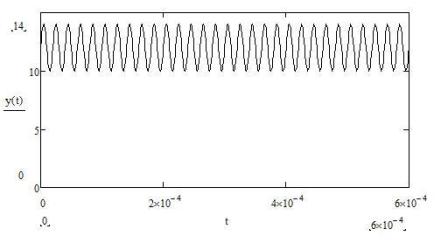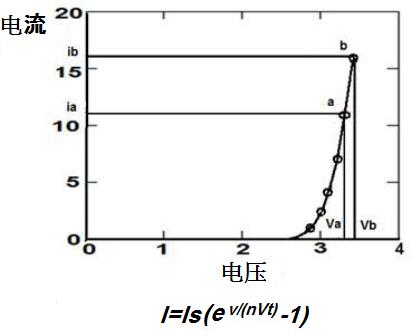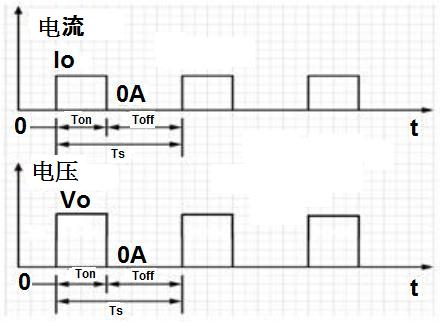

led lamp impact on vision and health

Figure 3 The voltage waveform across LED lamp; horizontal axis is time, vertical axis is voltage.
Lamp brings ripple with high frequency, ripple is small voltage variation around the DC voltage. The voltage waveform across the LED lamp is shown in Figure 3.
pupils dilate in dark environment and contract in bright environment. High frequency ripple flicker brings brightness variation so fast that pupils cannot dilate and contract fast enough. Strong light on the retina hurt the retina.
Output ripple flicker: The relation between current and voltage of LED is exponential, so a little voltage ripple drift can cause current many times change.
Shockley Diode Equation Describes the Current vs Voltage Relation for light emitted diode: I=Is*(eV/(n*Vt)-1) Where, I is the diode current, IS is the reverse bias saturation current (or scale current), V is the voltage across the diode, VT is the thermal voltage, VT=25.85mv, n is the ideality factor, n=1~2. The current vs voltage is an exponential curve. When voltage changes a little, current changes dramatically.

From Figure 3, we see most of power supply has some voltage ripple. The ripple is the voltage small variation near the DC voltage across LED lamps.
From figure 4, we see when the LED voltage has a small change from Va to Vb, LED current has a dramatic change from ia to ib. The brightness is proportional to output power. When you draw a horizontal line from operating point to current axis and draw a vertical line from operating point to voltage axis, Output power of the operating point is the area of the rectangular composed of these two lines, current axis and voltage axis. We can see when the operating point changes from a to b, the area increases at least 1/3. The brightness increases at least 1/3. If such a brightness change is in low frequency, the pupils will keep adjusting and cause eyestrain. For long term, myopia is induced. If such a brightness change is in high frequency, the pupil cannot keep up, it will hurt the retina.
Recent work by Albert et al has shown the development of progressive stages of retinal degeneration and choroidal neovascularization after long-term intense cyclic light exposure in albino rats.[21]
Arnold Wilkins, Dept. of Psychology, University of Essex; UK,Jennifer Veitch, National Research Council Canada,Ottawa; Canada and Brad Lehman, Dept. Elect.& Comp. Eng, Northeastern University; USA did research on LED flickering on health: low-frequency flicker between 3 and 70 Hz can cause seizures; invisible flicker (70 Hz) above can cause malaise, headache and visual impairment[12].
Market LED lamps light contain some components such as ultraviolet, infrared, strong red, strong green or strong blue light that are harmful to human eyes.
Peking Union Medical College Hospital found guinea pigs raised in long-wavelength red light illumination developed a significant myopia.[13].
Fudan University found guinea pigs in the green-light group had a somewhat myopic refractive status[14].
Northrop Grumman Information Technology found exposure to near-UV/blue wavelength sources at "safe"exposure levels can induce a veiling glare intense enough to degrade visual performance[15].
University of Texas Southwestern medical center in Texas found strong blue light can cause macular degeneration and other vision problem[16].
Karolinska Institute in Sweden found the blue light hazard (excitation peak 440 nm), have a major impact on photoreceptor and retinal pigment epithelium function, inducing photochemical damage and apoptotic cell death[17],and .
Laboratory of Pharmacology, National Institute of Environmental Health Sciences concluded that blue light induced retinal injury and macular degeneration[18]. Blue light induce damage to retinal pigmented epithelial cells. [23]
Some switching power supplies bring strong electromagnetic radiation higher than international standard. Strong electromagnetic radiation may cause cancer.
Market Dimming way brings high frequency brightness flicker by turning on and off the dimming switch with high frequency. High frequency flicker will hurt retina.
LED is turned on for time Ton and is turned off for time Toff with high frequency.Pupils cannot keep up, the strong light will hurt retina.
The waveform of Io and Vo for LED is shown as Figure 5.

Io is the current through LED and Vo is the voltage across LED; Ton is the time when LED is on and Toff is the time when LED is off; Ts is switching period.
Battery without feedback will bring voltage variation and cause low frequency brightness flicker. Low frequency flicker cause eyestrain and myopia.
[12]Wilkins, A.,Veitch, J.,Lehman, B. LED Lighting Flicker and Potential Health Concerns: Energy Conversion Congress and Exposition(ECCE),2010 IEEE, Date of Conference: 12-16 Sept. 2010, page 173.
[13] Long Q, Chen D, Chu R, Illumination with monochromatic long-wavelength light promotes myopic shift and ocular elongation in newborn pigmented guinea pigs.Cutan Ocul Toxicol. 2009;28(4):176-80. doi: 10.3109/15569520903178364.
[14] Wang F, Zhou J, Lu Y, Chu R, Effects of 530?nm green light on refractive status, melatonin, MT1 receptor, and melanopsin in the guinea pig. Curr Eye Res.2011 Feb;36(2):103-11.doi:10.3109 /02713683. 2010.526750.Epub 2010 Dec 15.
[15]Zuclich JA, Previc FH, Novar BJ, Edsall PR, Near-UV/blue light-induced fluorescence in the human lens: potential interference with visual function, J Biomed Opt. 2005 Jul-Aug;10(4):44021
[16]Walker DP, Vollmer-Snarr HR, Eberting CL., Ocular hazards of blue-light therapy in dermatology.J Am Acad Dermatol. 2012 Jan;66(1):130-5. doi: 10.1016/j.jaad.2010.11.040. Epub 2011 May 4.
[17] Algvere PV, Marshall J, Seregard S, Age-related maculopathy and the impact of blue light hazard,Acta Ophthalmol Scand.2006 Feb;84(1):4-15.
[18] Wielgus AR, Collier RJ, Martin E, Lih FB, Tomer KB, Chignell CF, Roberts JE, Blue light induced A2E oxidation in rat eyes--experimental animal model of dry AMD, Photochem Photobiol Sci. 2010 Nov;9(11):1505-12. doi: 10.1039/c0pp00133c. Epub 2010 Oct 5.
[21] Albert DM, Neekhra A, Wang S, Darjatmoko SR, Sorenson CM, Dubielzig RR et al. Development of choroidal neovascularization in rats with advanced intense cyclic-light-induced retinal degeneration,Arch Ophthalmol 2010; 128(2):212-222.
[22] PN Youssef, N Sheibani and DM Albert, Retinal light toxicity, Eye (2011) 25, 1-14; doi:10.1038/eye.2010.149; published online 29 October 2010.
[23] Sparrow JR, Nakanishi K, Parish CA, The lipofuscin fluorophore A2E mediates blue light-induced damage to retinal pigmented epithelial cells, Invest Ophthalmol Vis Sci.2000 Jun; 41(7):1981-9.